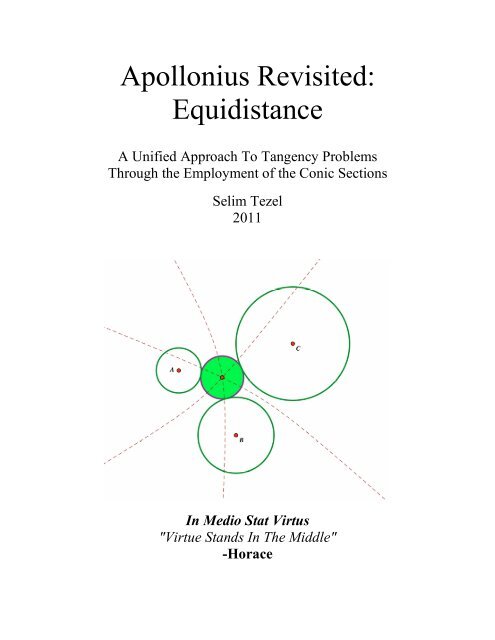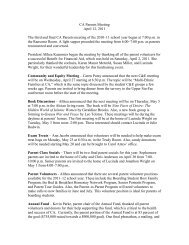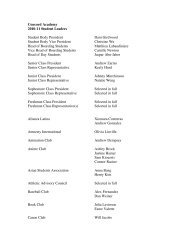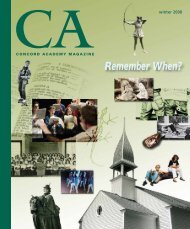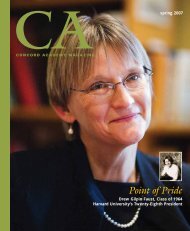Apollonius Revisited Equidistance
Apollonius Revisited: Equidistance - Concord Academy
Apollonius Revisited: Equidistance - Concord Academy
- No tags were found...
You also want an ePaper? Increase the reach of your titles
YUMPU automatically turns print PDFs into web optimized ePapers that Google loves.
<strong>Apollonius</strong> <strong>Revisited</strong>:<strong>Equidistance</strong>A Unified Approach To Tangency ProblemsThrough the Employment of the Conic SectionsSelim Tezel2011In Medio Stat Virtus"Virtue Stands In The Middle"-Horace
<strong>Apollonius</strong> <strong>Revisited</strong>: <strong>Equidistance</strong>A Unified Approach To Tangency Problems Through the Employment of the ConicSectionsIntroduction &Motivation(A)Definition: DistanceDistance between:Two pointsA point and a lineA point and a circleTwo linesTwo circles(B)Definition: <strong>Equidistance</strong>Definitions:Perpendicular BisectorParabolaHyperbolaEllipse(C)Definition: EquilocusEquilocus of:Two pointsTwo linesA point and a lineA point and a circleA line and a circleTwo circles(D)<strong>Apollonius</strong> Tangency Problems: via <strong>Equidistance</strong> & EquilocusPPP, PPL, PPC, PLC, LLL, LLP, LLC, CCP, CCL, CCCApollonian GasketFurther ResearchAppendix:Constructing Parabola, Hyperbola, Ellipse in Geometer's SketchpadConstructing the intersection of two loci in Geometer's SketchpadConstructing the <strong>Apollonius</strong> Circle
Introduction and Motivation:<strong>Apollonius</strong> <strong>Revisited</strong>: <strong>Equidistance</strong>A Unified Approach To Tangency ProblemsThrough the Employment of the Conic SectionsSelim Tezel 2011The approach to the <strong>Apollonius</strong> tangency problems described in this paper has beenmotivated by a desire to find a simple and unified approach to solving these challengingand beautiful problems. The extensive effort by 17 & 18th century geometers to solvethese problems posed by <strong>Apollonius</strong> (see Alfred Posamentier's Advanced EuclideanGeometry), employ a wide variety of construction ideas and techniques, which, whileingenious, in my opinion lack a certain aesthetics of simplicity as well as a unified insightinto the essential nature of these problems. It is important to note that in the attempt tofind a unified understanding of these problems I have abandoned the traditional approachto solve these problems with compass and straight-edge. Such work has already beendone by the geometers of the past and we know that they can be done. Instead, full powerof the dynamic visualization software Geometer's Sketchpad has been used to generateand explore interactions of loci relevant to the tasks at hand. My aim here is to explorethe tangency problems from the simple and unified perspective of the single concept of"equidistance". In the paper, definition of the word "Equilocus" has been given as the"middle path" between pairs of geometric objects. Below is a summary of some of theconclusions reached that are ultimately used in solving the Apollonian tangencyproblems:Object1 Object2 Equilocus: Middle PathPoint Point Perpendicular BisectorLine Line (intersecting) Angle BisectorPoint Line ParabolaCircle Line ParabolaCircle Point (Outside) HyperbolaCircle Circle (Outside) HyperbolaCircle Point (Inside) EllipseCircle Circle (Inside) EllipseGiven that so many books of <strong>Apollonius</strong> have been lost to history, though we will neverknow the truth, I have a strong feeling that the master himself was aware of theconnection of the conic sections (which he extensively explored in his Conics) to thetangency problems he posed.Acknowledgements:The work for this paper started upon watching a short and fun video called: "Doodling inMath Class: Infinity of Elephants" created by Vi Hart on the topic of the Gasket of<strong>Apollonius</strong> and I would like to express her my thanks for inspiring the initial thought forthis project. I also would like to thank all my former students in my Advanced Topics inMathematics: Theories of Infinity course, especially Woody Ahern, who helped mecorrect errors in the earlier drafts of this paper.
(A) DISTANCEDefinition: Distance between two non-overlapping geometric objects is the length of theshortest segment joining them.Distance between: Two points A, B is AB the length of the segment joining them.Distance between: A point A and a line k (not containing A) is AB, the length of theperpendicular segment from A to k.Exercise: Show that the perpendicular segment is the shortest possible segment betweenthe line and the point, thus satisfies the definition of "distance" given.
Distance between: A circle C and a point A (outside the circle) is AB, which is created byjoining the center of circle C to the point A and removing the radius, r.Thus AB=AC-CB=AC-r= AC " r!Exercise: Show that the segment thus formed is the shortest possible segment betweenthe circle and the point thus satisfies the definition of distance given.Distance between: A circle C and a point A (inside the circle) is AB, which is created byjoining the center of circle C to the point A and removing this from the radius, r.Thus AB=CB-AC= r-AC= AC " r!Distance between: Two lines j, k is(a) zero, if lines intersect(b) AB, the length of a perpendicular segment between them if lines are parallel
Distance between: Two external circles P, Q is AB, which is created by joining thecenters P&Q and removing the two radii, R & r.Thus AB= PQ-(PA+QB). AB=PQ-(R+r)= PQ " R " r!Distance between: Two circles, Q inside P, is AB, which is created by joining the centersP&Q with a ray and removing the distance between the centers and the smaller radius. r,from the bigger radius, R. Thus AB=PA-(PQ+QB)=R-(PQ+r)= PQ " R " r!Exercise: If two circles are tangent or intersecting the distance between them should bezero. Do the definitions given allow for this situation? How do the distance formulasdetect these cases?
(B) EQUIDISTANCEDefinition: A point P is equidistant to two points A and B if and only if PA=PBDefinition: Perpendicular Bisector of a segment is a line that is perpendicular to thesegment at its midpoint.Exercise: Show that perpendicular bisector of a segment is the set of all pointsequidistant from the end points of the segmentDefinition: Parabola is the set of all points on a plane that are equidistant to a point(focus) and a line (directrix)
Definition: Ellipse is the set of all points on a plane whose sum of distances from twopoints (foci) is a constant.Exercise: Ellipse can also be defined in terms of equidistance. Can you see how?Definition: Hyperbola is the set of all points on a plane whose difference of distancesfrom two points (foci) is a constant.Exercise: Hyperbola can also be defined in terms of equidistance. Can you see how?
Research: Construct and investigate(a) the set of all points whose ratio of distances from two fixed points is a constant. (see<strong>Apollonius</strong> Circle at the Appendix)(b) the set of all points whose product of distances from two fixed points is a constant.(c) the set of all points whose sum/difference/product/ratio of distances from N fixedpoints is a constant (N=3,4,…) (see my former student Bilge Demirkoz's Trisoid as astarter)
(C) EQUILOCUSNote: Please refer to the Appendix to explore how to construct the conic sections inGeometer's Sketchpad.Definition: Equilocus of a pair of geometric objects is the set of all points that areequidistant to these objects. Informally we can think of equilocus as the "middle path"between the objects.Example: The equilocus of a parabola and a point A (which happens to be parabola'sfocus) is shown here. All the points on the equilocus is equidistant to the parabola andpoint A.Equilocus of : Two points is the perpendicular bisector of the segment joining the pointsProof: Let P be an arbitrary point equidistant to A and B. M, the midpoint of segmentAB is also equidistant to A, B. Together they determine the perpendicular bisector ofAB.!!
Equilocus of:(a)Two intersecting lines are the angle bisectors of the angles formed by the lines.Proof: Points on the angle bisector are equidistant to the sides of the angle.(b)Two parallel lines is a mutual parallel running in the middle between themExercise: Prove that this line is unique and satisfies the criteria for being an equilocus forthe two parallel lines.Equilocus of: A point and a line is the parabola with the point as its focus and the line asits directrix.Proof: Follows directly from the definition of a parabola.
Equilocus of: A circle C and a point A (outside of C) is the single branch of thehyperbola with foci A and C and the constant difference of distances equal to the radiusof circle C.Note the hyperbola bends towards the point and away from the circle.Proof: We wish to locate all points P such that PB=PA. As PB=PC-CB we have:PA=PC-CB and thus CB=PC-PA.As CB is the radius of the circle C it is a constant thus we have PC-PA=constantsatisfying the definition of a hyperbola with A and C as foci.
Equilocus of: A circle C and a point A (in its interior) is an ellipse with foci A and C andconstant sum of distances the radius of circle C.Exercise: Study the diagrams below to explain why ellipse described is the equilocus ofthe given point and circle containing the point.
Equilocus of: A line k and a circle C is a parabola with C the center of circle as its focusand a line k' shifted parallel to the given line k by the radius of the circle away from thecircle as its directrix.Exercise: Study the diagram below to explain why parabola described is the equilocus ofthe given line and circle.
Equilocus of: Two external circles C, D is a single branch hyperbola with the centers ofthe two circles C and D as its foci and the difference in the radii of circles (R-r) as theconstant difference in distances.Exercise: Study the diagrams below to explain why hyperbola described is the equilocusof the two given circles.
Note the hyperbola bends away from the bigger circle towards the smaller circle.The situation is identical to equilocus of a point and a circle of radius R-rExercise: What happens when the two circles have equal radii?
Equilocus of: Two circles D inside C is an ellipse with the centers of the two circles Cand D as its foci and the sum of the radii of circles (R+r) as the constant sum in distances.Exercise: Study the diagrams below to explain why ellipse described is the equilocus ofthe two given circles.Hint: What is PC+PD?
Hint: PC+PD=(R-d)+(r+d)=R+r = constant. What is the significance of this?Note that the situation is identical to equilocus of a circle of radius R+r and a point insideit.
(D) <strong>Apollonius</strong> Tangency Problems: Explored via <strong>Equidistance</strong> & EquilocusNote: Please refer to the Appendix to explore how to construct the intersections of twoloci in Geometer's Sketchpad.Task: Construct a circle through one or more points (P), tangent to one or more lines (L)and/or tangent to one or more circles (C).PPPTask: Construct a circle through three points A,B,C.Solution: via intersection of two perpendicular bisectorsKey Observation: The center of the tangent circle is equidistant to the three points.Equilocus of two points is the perpendicular bisector of the segment they determine.PPLTask: Construct a circle through two points A,B tangent to one line kSolution: via intersection of a perpendicular bisector and a parabolaKey Observation: The center of the tangent circle is equidistant to two points and the line.Equilocus of two points is the perpendicular bisector and equilocus of a point and a lineis a parabola. Note: two solutions are possible.
PPCTask: Construct a circle through two points A,B tangent to one circle CSolution: via intersection of a perpendicular bisector and a hyperbolaKey Observation: The center of the tangent circle is equidistant to two points and a circle.Equilocus of two points is the perpendicular bisector and equilocus of a point and a circleis a hyperbola. Note: two solutions are possible.PLCTask: Construct a circle through a point P, tangent to one line L and tangent to a circle CSolution: via intersection of a parabola and a hyperbolaKey Observation: The center of the tangent circle is equidistant to the point, the line andthe circle. Equilocus of a point and a line is a parabola and equilocus of a point and acircle is a hyperbola. Note: two solutions are possible.
LLLTask: Construct a circle tangent to three lines j,k,lSolution: via intersection of angle bisectorsKey Observation: The center of the tangent circle is equidistant to three lines. Equilocusof two intersecting lines is the angle bisector. Note: four solutions are possible.
LLPTask: Construct a circle through a point A and tangent to two lines j, kSolution: via intersection of angle bisector and a parabolaKey Observation: The center of the tangent circle is equidistant to two lines and the point.Equilocus of two intersecting lines is the angle bisector and equilocus of a point and aline is a parabola. Note: two solutions are possible.
LLCTask: Construct a circle tangent to two lines j, k and a circle CSolution: via intersection of angle bisector and a parabolaKey Observation: The center of the tangent circle is equidistant to two lines and thecircle. Equilocus of two intersecting lines is the angle bisector and equilocus of line anda circle is a parabola. Note: two solutions are possible.
CCPTask: Construct a circle through a point A and tangent to two circles C, DSolution: via intersection of two hyperbolasKey Observation: The center of the tangent circle is equidistant to the two circles and tothe point. Equilocus of a point and a circle is a hyperbola.
CCLTask: Construct a circle tangent to a line k and two circles C, DSolution: via intersection of a hyperbola and a parabolaKey Observation: The center of the tangent circle is equidistant to two circles and theline. Equilocus of two circles is a hyperbola and equilocus of a line and a circle is aparabola.
CCCTask: Construct a circle through tangent to three circles A,B,CSolution: via intersection of two hyperbolasKey Observation: The center of the tangent circle is equidistant to three circles. Equilocusof two circles is a hyperbola.Exercise: There are actually 8 possible solutions to this problem (Why? Hint: 2*2*2=8)Some of these solutions involve the tangent circle containing some or all of the givencircles on the inside. Explore these possibilities. You may wish to review ellipse as anequilocus.
Challenge: Study special cases not covered above such as a circle being inside anotherone in the CCP case etc.Challenge: Using all the techniques described here construct several levels of inscribedtangent circles in a triangle.Challenge: Using all the techniques described here construct several levels of theApollonian Gasket.
Research: Going beyond <strong>Apollonius</strong>: the strange new world of EquilociDefine distance between and then construct equilocus between(a) a point and a parabola(b) a point and an ellipse
(c) a point and a hyperbolaAdvanced Research: Really going beyond <strong>Apollonius</strong>Let the notation representP:point, L:line, C:circle, R:parabola, E:ellipse, H:hyperbola(a)Construct the equilocus between any two conic sectionsRR, EE, HH, RE, RH, EH, CR, CE, CH etc.(b)Then explore how to construct a circle tangent to the given objects under allimaginable cases beyond the 10 basic ones considered by <strong>Apollonius</strong>:RRR, EEE, HHH, PPR, PPE, PPH, PRR, PEE, PHH, PRE, PRH, REH, etc. etc..
Appendix: Constructing the Parabola in Geometer's Sketchpad-Draw a line (directrix)-Hide the two points to avoid confusions later on (Display Menu)-Draw a point, Label it “Focus”. Label the line “directrix”Focusdirectrix-Construct a movable point Q on the line.FocusdirectrixQ Movable Point-Join Q to Focus with a segment and find its midpoint.FocusdirectrixQ Movable Point
- Construct the perpendicular bisector of the segment.FocusdirectrixQ Movable Point-Construct through point Q a perpendicular to the directrix. This will intersect the otherperpendicular. Construct the intersection point and label it P. P is the point on theparabola.P (point on parabola)FocusdirectrixQ Movable Point-Note that: as P is equidistant to the Focus and to the directrix, it satisfies the condition inthe definition of the parabola and is thus a point on the parabola.P (point on parabola)FocusdirectrixQ Movable Point
If you wish to explore parabola to be created by an animation follow the next two stepselse you should skip directly to the locus construction step.-Select and Trace P via Display menuP (point on parabola)FocusdirectrixQ Movable Point-Select Q the movable point and create an Animation Button via Edit Menu ActionButton Animation. Enjoy!Animate PointFocusP (point on parabola)directrixQ Movable Point-Select Q and then P and Construct Locus. Remember Locus means: as the point Qmoves on its path (the directrix) what will the constructed point P do? It is basically apermanent trace.LocusFocusP (point on parabola)directrixQ Movable Point
-Hide all but the Focus, the directrix and the parabola (Locus). Move the Focus anddirectrix closer to see the effect on the parabola. Do you see how smaller distancebetween the Focus and directrix leads to a steeper parabola?Recall the basic equation of a parabola y = ax 2 where a = 14 p ,p: distance between vertex and directrix=distance between vertex and focus!!FocusSmall p => Large a=> steep paraboladirectrixFocuslarge p => small a=> flatter paraboladirectrix
F1 (sun)Appendix: Constructing the Ellipse and the Hyperbola (A Unified Approach)-Draw a point and label it F1.- Create a circle with center labeled F2 and radius control point that encompasses F1-Create a (movable) point M on the circle and the line through F2 and M
-Construct a segment between M and F1 and its midpoint-Construct the perpendicular bisector of the segment between M and F1 and construct(via arrow click) P, the intersection of the perpendicular bisector with line through F2and M .
-Construct the Locus of point P (select M, the driver and P, the driven and ConstructLocus)-If you wish to make an ellipse custom tool, hide everything except F1, F2, EllipseLocus and the radius control point-Select all these remaining objects to create an “Ellipse Tool” from the custom tool menu.
- This tool will be handy if, say, you wished to create a model of the solar system withthe planetary orbits as ellipses. In such a construction the sun would be at F1 and all theorbits would have F1 in common but F2's different.-Please note that if you move F1 outside the circle F2 you get a hyperbola with 2branches
-If you wish to have a hyperbola with a single branch you can do so by making sure youstart the construction with a ray through F2 and M rather than a line.-To understand why these constructions satisfy the definitions of ellipse and hyperbolastudy the diagrams below:Note: The sum of the distances PF2 and PF1 is a constant: the radius of the circle
Note: The difference between the distances PF2 and PF1 is a constant: the radius of thecircle
Appendix: Constructing the intersection of two loci in Geometer's Sketchpad.At the time of the writing of this paper (summer 2011), Geometer's Sketchpad 5.0, whileallowing the construction of the intersection of a locus and a line/circle, does not allowthe construction of the intersection of two arbitrary loci. This appendix will demonstratehow to overcome this issue for most cases relevant for the topic of the paper.Inspiration/Main idea: given two functions f(x) and g(x), the intersection(s) of f(x) andg(x) corresponds to the zero(s) of the difference function f(x)-g(x).-Given two loci-Create a line through two free points A and B appropriately placed beneath the loci (toplay the role of the x-axis)
-Create a movable free point M on this line and construct a perpendicular through thispoint to the line intersecting the loci at points P and Q.-Use Transform>Mark Vector option in Sketchpad to capture the vector from Q to P andtranslate M by this vector to create M'. Note that MM'=QP and this represents thedifference between the two loci.
-Construct the locus of M' as M moves along its line. This locus represents the"difference function". Create R, the intersection of this locus with the line AB.!-Construct a perpendicular through R that intersects the loci at I. This is the intersectionwe have hoped to construct.
-Hide all but the loci and two points A, B and the constructed point I. Create a Sketchpadcustom tool for general use. The script view of this tool should have 4 givens: two lociand two points A, B (defining the "x-axis", which can later be hidden) and should createonly the point I, the intersection of loci.Note: For maximum dynamic usability when using this tool it is recommended that pointsA and B are "planted" on intrinsic points of the loci such as the non-common foci of twohyperbolas etc. rather than on random positions on the plane. While this will allow forsome flexibility if initial conditions are altered, note that the technique described herecannot hope to be create intersections of loci under all general cases (which is probablywhy the designers of Sketchpad have not yet implemented a general loci intersectionoption. The general task must be a non-trivial programming issue.)
Appendix: Constructing an <strong>Apollonius</strong> Circle-Lets say we wish to find the set of all points that are respectively in the AM:MB ratiofrom the points A and B.-Consruct perpendiculars from A and B.-Construct circles of radius AM and MB respectively from A and B.
-Construct E and F, the intersections of the perpendiculars with the circles and then theline EF intersecting the line AB at D.!!-Find the midpoint of theM.DM and construct a circle with this point as the center through!
-This circle (called the <strong>Apollonius</strong> Circle) is the set of all points that are in AM:MB ratioto points A to B.Exercise: Why does this construction work?


